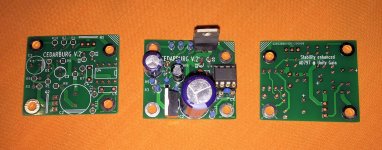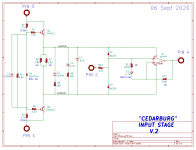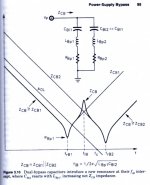Greetings everyone! I really want to learn some knowledges about the analog semiconductor. Unlike the CPU\GPU\SoC sector, nearly everyone talked about "X nm", transistor count and etc. Very few audio-circuit amateurs will say something about the key technologies that makes our chip OPAMPs or even new BJT transistors better.
So, I·m curious about what have changed the analog semis in the past ten years?
From OPAMPs to the low noise LDOs and even the discrete transistors, too many high performance new models has came out within the decade, and what are the tech trend behand them?
I only know something that was stated on the official website, say TI has a ”high voltage CMOS“ tech that makes my old daddy stuned .
.
So, I·m curious about what have changed the analog semis in the past ten years?
From OPAMPs to the low noise LDOs and even the discrete transistors, too many high performance new models has came out within the decade, and what are the tech trend behand them?
I only know something that was stated on the official website, say TI has a ”high voltage CMOS“ tech that makes my old daddy stuned
Advances in production technique for very dense CPU chips etc have to a small extent transferred to small scale devices. That is mainly in the accuracy or precision of the etching and metallurgy and doping of the semiconductor I presume. It means the op amps or transistors have improved.
So this is the overall and indirect improvement comes from the whole industry.Advances in production technique for very dense CPU chips etc have to a small extent transferred to small scale devices. That is mainly in the accuracy or precision of the etching and metallurgy and doping of the semiconductor I presume. It means the op amps or transistors have improved.
Maybe you could ask it on the OPA1656 thread, https://www.diyaudio.com/community/...cmos-audio-op-amp.335416/page-37#post-7116055 Chances are that you won't get a very specific answer due to company confidentiality, but who knows?
I guess the expiration of the Monticelli patent in 2004 and the use of nested compensation methods are the most important developments, more than advances in the manufacturing technologies, but I may very well be wrong. The X nm technologies you referred to in the opening post are a nightmare for analogue circuits: designing something that still fits in the damn small supply voltages that those processes can survive is anything but straightforward. The advantage is that the transistors are very fast, but that hardly matters for audio circuits. I'm sure op-amps that can survive +/- 15 V must be using rather coarser processes.
I guess the expiration of the Monticelli patent in 2004 and the use of nested compensation methods are the most important developments, more than advances in the manufacturing technologies, but I may very well be wrong. The X nm technologies you referred to in the opening post are a nightmare for analogue circuits: designing something that still fits in the damn small supply voltages that those processes can survive is anything but straightforward. The advantage is that the transistors are very fast, but that hardly matters for audio circuits. I'm sure op-amps that can survive +/- 15 V must be using rather coarser processes.
Educated guesses: we know from the OPA1656 thread that the input transistors have anti-parallel diodes across them because their gate oxide couldn't survive with only ESD protection to the supply rails. That means they are not using an antique process with very thick gate oxide, but probably some process that features "high-voltage" MOSFETs with extended drain regions in addition to normal MOSFETs that can only handle a very limited voltage. Even for those, they will probably still be using fairly old-fashioned devices with negligible gate tunnelling leakage (say, at least 90 nm feature size).
Would you please quote some names of those materials? Thanks a lot!Seems like a lot of newer materials being used in RF applications
I knew SiGe is used in RF applications, but I didn't know it is also used in something as mundane as an audio op-amp.Seems like a lot of newer materials being used in RF applications
GaN and SiGe primarily (in production). I've also seen some materials like graphene used at the R&D stage but no idea if any progress has been made there. I see multiple variants of GaAs in use too but my impression is that's slightly older, not sure how much materials development around it is more recent, but it's being used in very high ghz applications.Would you please quote some names of those materials? Thanks a lot!
The OPA1611 spec sheet shows greater phase margin (figure 5) vs the OPA1656 (figure 6.5) and attendant improvements in small-signal overshoot, which might be due to the faster SiGe process. Now whether this would make a difference in audio apart from making circuits less prone to instability [1], who can say?I knew SiGe is used in RF applications, but I didn't know it is also used in something as mundane as an audio op-amp.
[1] apparently still a problem with dodgy layouts, and ultrasonic oscillation would mess up your sound.
he OPA1611 spec sheet shows greater phase margin (figure 5) vs the OPA1656 (figure 6.5) and attendant improvements in small-signal overshoot, which might be due to the faster SiGe process. Now whether this would make a difference in audio apart from making circuits less prone to instability [1], who can say?
[1] apparently still a problem with dodgy layouts, and ultrasonic oscillation would mess up your sound.
[1] apparently still a problem with dodgy layouts, and ultrasonic oscillation would mess up your sound.
Operate "high bandwidth, suspicious phase margin" IC opamps at a gain greater than 1. Presto, MUCH better gain margin, MUCH better phase margin, MUCH better overshoot/undershoot. Nelson Pass has been recommending this for more than a decade.
Here's one way to skin the cat, applied to the notorious AD797 whose datasheet says it is stable at a noise gain of 2x (but NOT at unity gain).
_
Here's one way to skin the cat, applied to the notorious AD797 whose datasheet says it is stable at a noise gain of 2x (but NOT at unity gain).
_
Attachments
- Home
- Design & Build
- Parts
- A question about analog-semiconductive tech development in the recent Decade.


